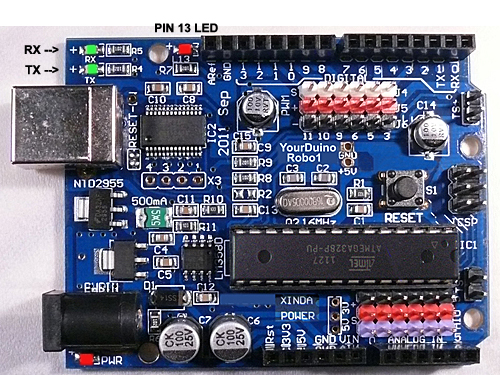YourDuinoRobo1 ArduinoUNO
Jump to navigation
Jump to search
YourDuinoRobo1 Compared To The ArduinoUNO
There are over 100 "Arduino Compatible" microcomputer boards. They may be physically different in size and details but they all have these components:
- An ATMEL ATMega Microcontroller chip such as a 328, 1280, 2560
- A Programming Interface (Usually USB) connecting to a personal computer running the Arduino IDE software
- Compatibility with the Software Sketches uploaded from the Arduino IDE
- Power inputs from USB, Batteries or plug-in power supplies
- External connections to various Input and Output devices
On the left is theArduino UNO (link) On the right or below is theYourDuino Robo1 (link) It is compatible with the UNO (has the same size, connectors, and functionality). It has several added connectors, features and upgrades.


What About "Arduino Compatibles, Arduino Derivatives, Arduino Clones and Arduino Counterfeits" ??
The Arduino project – both hardware and software – is open-source. The schematics, hardware design files, and source code are all freely available. Arduino is under a Creative Commons Share Alike license. Anyone can duplicate the design or make modifications or additions to it and market the resulting product as long as they, in turn, make all the designs available.
- Arduino Derivatives: The YourDuinoRobo1 is a derivative design which adds functionality and makes changes to the original design, and is marked with it's own artwork/identification. Another example is the Sparkfun Redboard.
- Arduino Clones: Are available on Ebay and other sources. They use the exact Arduino open-source design but have their own markings and do not pretend to be original Arduinos.
- Arduino Counterfeits: (Also regrettably available on Ebay etc) Violate the Arduino Copyrights by copying the Arduino markings and attempt to look 'just like' an Arduino from Arduino.cc
What added features does the YourDuinoRobo1 provide?
- USB-to-Serial Transceiver: The Arduino UNO uses an ATmega16U4 microcontroller with custom firmware to convert between USB and serial. User experience has shown that sometimes the internal firmware programming of the interface chip becomes corrupted and the USB stops working. (It is possible to get it reloaded). The Robo1 uses the FTDI FT232RL like the Arduino Duemilanove. The FTDI USB chip can not fail to upload software due to USB firmware corruption or problems.
- LED placement is more ergonomic: can been seen easily when a shield is used
- Built-in Sensor Shield connectors for Servos or other Digital or PWM applications, and 6 Analog inputs
- 5 free 3-pin cables with flat end to Robo1 and latched end to Electronic Bricks
- 5 free 3-pin cables with flat end to Robo1 and separate ends to connect to relay boards, many other devices
- Free USB Cable (50cm)
- Many Additional Power and Ground pins, space for optional 5V supply capacitor.
- Improved 3.3V power regulator provides up to 500ma
- ATMEL 328 processor can be run on either 5.0 or 3.3V for compatibility with new sensors and devices. See the small jumper to the left of the analog section. (NOTE: Some early versions do not have this populated).
Comparision Chart: Arduino UNO and YourDuino Robo1
COMPARISION |
ARDUINO UNO |
YOURDUINO ROBO1 |
| SIZE |
2.7 x 2.1" (68.58 x 53.34mm) |
2.7 x 2.1" (68.58 x 53.34mm) |
| USB Interface |
ATmega16U4 chip: programmed firmware |
FTDI FT232RL Chip |
| Windows Compatibility |
ALL since Win98 |
ALL since Win98 |
| MAC Compatibility |
OS X |
OS X |
| ATMEL MicroController |
ATmega328 |
ATmega328 |
| External Power |
7-12V |
7-12V |
| Operating Voltage |
5V |
5V or 3.3V |
| Digital I/O |
14 |
14 (6 have 3-pin connector) |
| Analog Input |
6 |
6 (6 have 3-pin connector) |
| 5V power pins |
3 |
17 |
| Ground Pins |
1 |
17 |
| 3.3V Current Available |
50ma |
500ma |
| Price |
$29 |
$16 |
zz